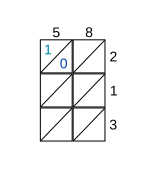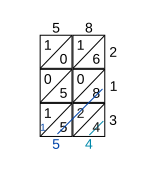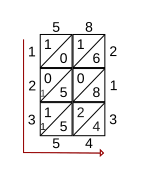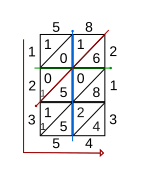Arabic numerals are the ten symbols most commonly used to write decimal numbers: 0, 1, 2, 3, 4, 5, 6, 7, 8 and 9. They are also used for writing numbers in other systems such as octal, and for writing identifiers such as computer symbols, trademarks, or license plates. The term often implies a decimal number, in particular when contrasted with Roman numerals.
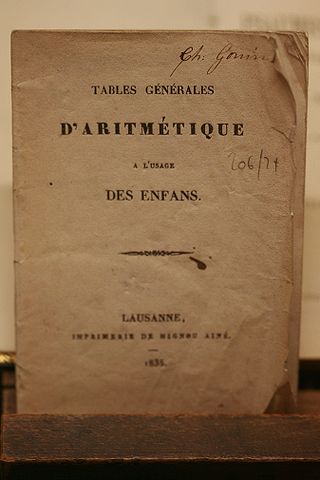
Arithmetic is an elementary part of mathematics that consists of the study of the properties of the traditional operations on numbers—addition, subtraction, multiplication, division, exponentiation, and extraction of roots. In the 19th century, Italian mathematician Giuseppe Peano formalized arithmetic with his Peano axioms, which are highly important to the field of mathematical logic today.

Fibonacci, also known as Leonardo Bonacci, Leonardo of Pisa, or Leonardo Bigollo Pisano, was an Italian mathematician from the Republic of Pisa, considered to be "the most talented Western mathematician of the Middle Ages".

Multiplication is one of the four elementary mathematical operations of arithmetic, with the other ones being addition, subtraction, and division. The result of a multiplication operation is called a product.

In mathematics, a multiplication table is a mathematical table used to define a multiplication operation for an algebraic system.
A multiplication algorithm is an algorithm to multiply two numbers. Depending on the size of the numbers, different algorithms are more efficient than others. Efficient multiplication algorithms have existed since the advent of the decimal system.

Liber Abaci is a historic 1202 Latin manuscript on arithmetic by Leonardo of Pisa, posthumously known as Fibonacci.

Napier's bones is a manually-operated calculating device created by John Napier of Merchiston, Scotland for the calculation of products and quotients of numbers. The method was based on lattice multiplication, and also called rabdology, a word invented by Napier. Napier published his version in 1617. It was printed in Edinburgh and dedicated to his patron Alexander Seton.
A numerical digit is a single symbol used alone or in combinations, to represent numbers in a positional numeral system. The name "digit" comes from the fact that the ten digits of the hands correspond to the ten symbols of the common base 10 numeral system, i.e. the decimal digits.
The promptuary, also known as the card abacus is a calculating machine invented by the 16th-century Scottish mathematician John Napier and described in his book Rabdologiae in which he also described Napier's bones.
Location arithmetic is the additive (non-positional) binary numeral systems, which John Napier explored as a computation technique in his treatise Rabdology (1617), both symbolically and on a chessboard-like grid.

Līlāvatī is Indian mathematician Bhāskara II's treatise on mathematics, written in 1150 AD. It is the first volume of his main work, the Siddhānta Shiromani, alongside the Bijaganita, the Grahaganita and the Golādhyāya.

The Hindu–Arabic numeral system or Indo-Arabic numeral system is a positional decimal numeral system, and is the most common system for the symbolic representation of numbers in the world.
In mathematics, ancient Egyptian multiplication, one of two multiplication methods used by scribes, is a systematic method for multiplying two numbers that does not require the multiplication table, only the ability to multiply and divide by 2, and to add. It decomposes one of the multiplicands into a set of numbers of powers of two and then creates a table of doublings of the second multiplicand by every value of the set which is summed up to give result of multiplication.
The grid method of multiplication is an introductory approach to multi-digit multiplication calculations that involve numbers larger than ten. Because it is often taught in mathematics education at the level of primary school or elementary school, this algorithm is sometimes called the grammar school method.
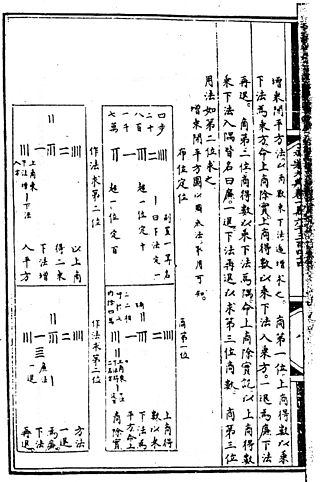
Rod calculus or rod calculation was the mechanical method of algorithmic computation with counting rods in China from the Warring States to Ming dynasty before the counting rods were increasingly replaced by the more convenient and faster abacus. Rod calculus played a key role in the development of Chinese mathematics to its height in Song Dynasty and Yuan Dynasty, culminating in the invention of polynomial equations of up to four unknowns in the work of Zhu Shijie.
Nasuh bin Karagöz bin Abdullah el-Visokavi el-Bosnavî, commonly known as Matrakçı Nasuh for his competence in the combat sport of Matrak which was invented by himself, was a 16th-century Turk-Bosniak statesman of the Ottoman Empire, polymath, mathematician, teacher, historian, geographer, cartographer, swordmaster, navigator, inventor, painter, farmer, and miniaturist.
Matrak is an Ottoman combat sport based on sword and shield fighting, Invented by the Ottoman Bosnian statesman, historian and scientist Nasuh Matrakčija Visočak (full name in Turkish: Nasuh bin Karagöz bin Abdullah el-Bosnavî) in the 16th century. It is played with wooden sticks covered with leather simulating a sword, and a wooden leather covered shield. The top of the sticks are rounded and slightly wider than the body resembling bowling pins. The game is a kind of combat simulation, and is played on a lawn. It was used by Ottoman soldiers as practice for melee combat.
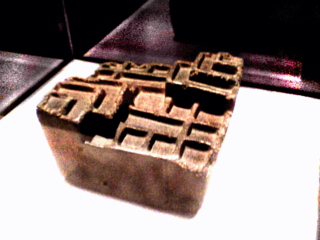
A yupana is an abacus used to perform arithmetic operations, dating back to the time of the Incas.
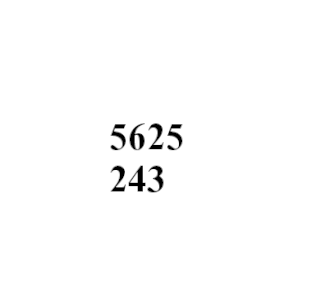
Principles of Hindu Reckoning is a mathematics book written by the 10th- and 11th-century Persian mathematician Kushyar ibn Labban. It is the second-oldest book extant in Arabic about Hindu arithmetic using Hindu-Arabic numerals, preceded by Kibab al-Fusul fi al-Hisub al-Hindi by Abul al-Hassan Ahmad ibn Ibrahim al-Uglidis, written in 952.
